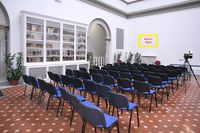Milestones:Enrico Fermi's major contribution to semiconductor statistics, Florence, Italy, 1926
This is a temporary page. The final version of this page can be found on the Engineering and Technology History Wiki
Title
Enrico Fermi's Major Contribution to Semiconductor Statistics, 1924-1926
Citation
Nobel laureate Enrico Fermi developed the quantum statistics that would be named after him while teaching at the School of Engineering of the University of Florence. The Fermi-Dirac statistics were a fundamental contribution to semiconductor physics and to the development of electronics.
Street address(es) and GPS coordinates of the Milestone Plaque Sites
43°47'54.40"N, 11°15'14.26"E, V. S. Marta, 3 50139 Florence, Italy
Details of the physical location of the plaque
The plaque will be mounted on the wall next to the Plaque enumerating the Presidents of the School since its foundation.
A photo of the proposed location is enclosed
How the intended plaque site is protected/secured
The School of Engineering is open to the public. The building has security personnel and alarms when it is closed.
Historical significance of the work
Source http://en.wikipedia.org/wiki/Fermi%E2%80%93Dirac_statistics#cite_note-Dirac1958-5
Before the introduction of Fermi–Dirac statistics in 1926, understanding some aspects of electron behavior was difficult due to seemingly contradictory phenomena. For example, the electronic heat capacity of a metal at room temperature seemed to come from 100 times fewer electrons than were in the electric current.[3] It was also difficult to understand why the emission currents, generated by applying high electric fields to metals at room temperature, were almost independent of temperature. The difficulty encountered by the electronic theory of metals at that time was due to considering that electrons were (according to classical statistics theory) all equivalent. In other words it was believed that each electron contributed to the specific heat an amount on the order of the Boltzmann constant k. This statistical problem remained unsolved until the discovery of F–D statistics. F–D statistics was first published in 1926 by Enrico Fermi[1] and Paul Dirac.[2] According to an account, Pascual Jordan developed in 1925 the same statistics which he called Pauli statistics, but it was not published in a timely manner.[4] According to Dirac, it was first studied by Fermi, and Dirac called it Fermi statistics and the corresponding particles fermions.[5] F–D statistics was applied in 1926 by Fowler to describe the collapse of a star to a white dwarf.[6] In 1927 Sommerfeld applied it to electrons in metals[7] and in 1928 Fowler and Nordheim applied it to field electron emission from metals.[8] Fermi–Dirac statistics continues to be an important part of physics.
The importance of the statistic is also attested in all semiconductor textbooks.
Features that set this work apart from similar achievements
This is a theoretical development which had several impacts in describing electron behavior. The most notable and highest technological impact of the theory is the development of semiconductor devices and industry. There is no similar contribution in this specific field.
Significant references
References. in brackets reference to the pertinent attachment:
E. Fermi, “Sulla quantizzazione del gas perfetto monoatomico,” Rend. Lincei (6) 3, 145-149 (1926), (reprinted in * pp. 181-185)
E. Fermi, “Zur Quantelung des idealen einatomigen Gases,” z. Physik 36, 902-912 (1926) (reprinted in * pp. 186-195) [P1] File:P1 1926 Zur Quantelung des idealen einatomigen Gases.pdf
- reprinted in Collected Papers (Note e Memorie) Volume I Italy 1921-1938, E. Fermi (ed. E. Amaldi, H. L. Anderson E. Persico, F. Rasetti, C. S. Smith, A. Wattemberg and E. Segré)), University of Chicago, 1962, with notes and remarks.
P. A. M. Dirac, On the Theory of Quantum Mechanics, Proc. R. Soc. Lond. A 1 October 1926 vol. 112 no. 762 pp. 661-677, doi: 10.1098/rspa.1926.0133 [P2] File:P2 Proc. R. Soc. Lond. A-1926-Dirac-661-77.pdf
H. Wilson, “The Theory of Electronic Semi-Conductors,” Proceedings of the Royal Society (London), A133, 1931, pp. 661-677. [P3] File:P3 Proc. R. Soc. Lond. A-1931-Wilson-458-91.pdf
J. Berdeen Nobel Lecture 1956, http://www.nobelprize.org/nobel_prizes/physics/laureates/1956/bardeen-lecture.pdf. [P4] File:P4 1956 bardeen-Nobel-lecture.pdf
Giuseppe Pelosi, Massimiliano Pieraccini, and Stefano Selleri, “Enrico Fermi in Florence,” IEEE Antennas and Propagation Magazine, Vol. 55, No. 6, December 2013, pp. 272-276. [P5] File:P5 IEEE APM 55 6 2013 Fermi.pdf
Supporting materials
Supporting material. in brackets reference to the pertinent attachment:
University of Florence Yearbook scan showing E. Fermi as a teacher of “Meccanica Razionale” (Analytical Mechanics), and specifying that the course was required for the students of the School of Engineering [S1] File:S1 annuari UniFI 1925-1926.pdf
Photograph of main hall showing perspective placement [S2]
